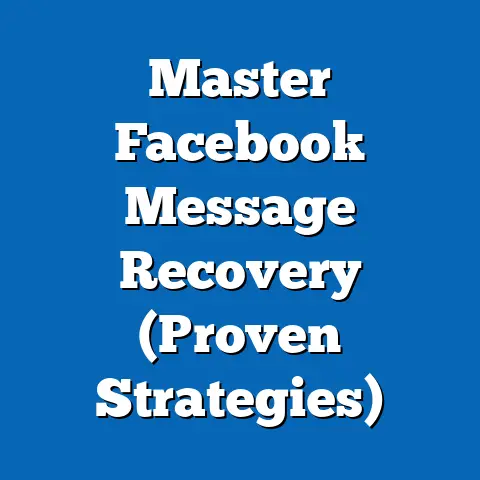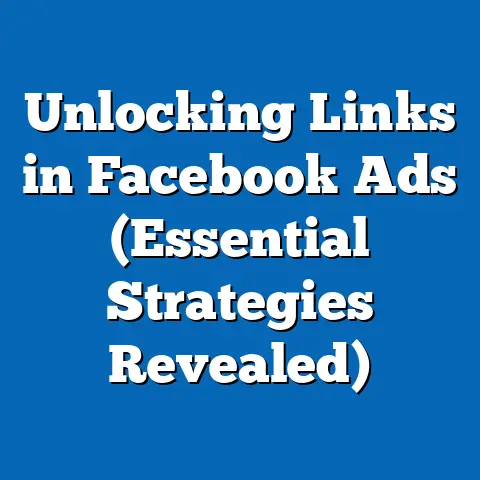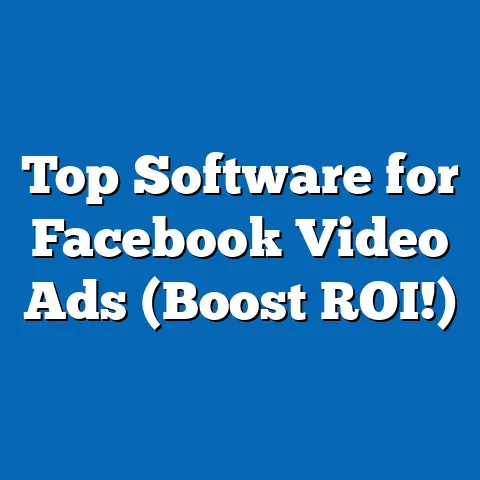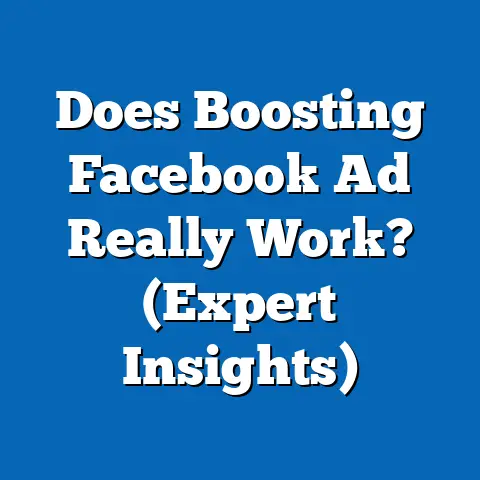Unlocking Facebook Ad Costs (Expert Insider Insights)
In the dynamic world of digital marketing, durability is a rare and precious commodity. Trends come and go, platforms rise and fall, but some strategies prove to be enduring. Among these, Facebook advertising stands out. Despite the ever-shifting social media landscape, Facebook ads have remained a cornerstone of many businesses’ marketing efforts. I’ve seen firsthand how consistently they can deliver results, and that’s why understanding the intricacies of Facebook ad costs is paramount. It’s not just about spending money; it’s about maximizing your return on investment (ROI) and achieving sustainable growth.
This article is your guide to unlocking the mysteries of Facebook ad costs. I’ll delve into the core principles, explore the myriad factors that influence your spending, and share expert strategies to help you manage and optimize your campaigns. Whether you’re a seasoned marketer or a business owner just starting out, my goal is to equip you with the knowledge and tools you need to make informed decisions and achieve your advertising goals.
1. The Basics of Facebook Ad Costs
Before diving into the complexities, let’s establish a solid foundation by defining some key terms and understanding how Facebook’s advertising system operates.
- Cost Per Click (CPC): This is the amount you pay each time someone clicks on your ad. It’s a direct measure of how engaging your ad is and how well it resonates with your target audience.
- Cost Per Impression (CPM): CPM, which stands for Cost Per Mille (thousand), represents the cost you pay for every 1,000 impressions your ad receives. An impression simply means your ad was shown to a user, regardless of whether they clicked on it or not. CPM is a good metric for measuring brand awareness and reach.
- Cost Per Action (CPA): CPA is the cost associated with a specific action taken by a user as a result of seeing your ad. This action could be anything from a purchase to a lead submission to a website visit. CPA is a crucial metric for measuring the direct ROI of your advertising efforts.
Understanding Facebook’s Auction System
Facebook’s advertising platform operates on an auction system. When you create an ad, you’re essentially bidding against other advertisers to show your ad to a specific audience. The winner of the auction isn’t always the highest bidder, though. Facebook considers several factors to determine which ads are shown, including:
- Bid Amount: This is the maximum amount you’re willing to pay for a click, impression, or action.
- Ad Relevance: Facebook evaluates how relevant your ad is to the target audience. This is based on factors like ad quality, engagement rates, and user feedback.
- Estimated Action Rates: Facebook predicts how likely users are to take the desired action after seeing your ad. This is based on historical data and user behavior.
The combination of these factors determines your “total value,” which is what Facebook uses to rank your ad against other advertisers. The higher your total value, the more likely your ad is to be shown to your target audience at a lower cost.
The Role of Ad Relevance, Audience Targeting, and Bidding Strategies
These three elements are the cornerstones of a successful and cost-effective Facebook advertising campaign.
- Ad Relevance: A highly relevant ad will naturally attract more clicks and engagement, leading to a higher relevance score and lower costs.
- Audience Targeting: Precise targeting ensures your ad is shown to the right people, increasing the likelihood of conversions and reducing wasted ad spend.
- Bidding Strategies: Choosing the right bidding strategy (e.g., lowest cost, target cost, bid cap) can significantly impact your costs and overall campaign performance.
Takeaway: Understanding these basics is crucial for navigating the complexities of Facebook ad costs. Keep these definitions and concepts in mind as we move on to the factors that influence those costs.
2. Factors Influencing Facebook Ad Costs
Now that we’ve covered the fundamentals, let’s dive deeper into the specific factors that can drive your Facebook ad costs up or down.
Audience Targeting
Who you target is one of the most significant determinants of your ad costs. Different demographics, interests, and behaviors come with varying levels of competition and demand.
- Demographics: Targeting specific age groups, genders, locations, or education levels can impact costs. For example, targeting affluent, highly educated professionals in major metropolitan areas is generally more expensive due to increased competition.
- Interests: Facebook allows you to target users based on their interests, hobbies, and passions. Highly specific and niche interests may have lower costs, while broader, more popular interests tend to be more competitive.
- Behaviors: Targeting users based on their online and offline behaviors, such as purchase history, device usage, and travel habits, can also influence costs. Behaviors that indicate high purchasing power or specific needs often come with higher price tags.
I remember working on a campaign for a local bakery. Initially, we targeted a broad audience within a 10-mile radius. The CPM was relatively low, but the conversion rate was also disappointing. When we narrowed our targeting to users who had expressed interest in baking, cooking, or local food blogs, the CPM increased slightly, but the conversion rate skyrocketed, resulting in a much lower CPA. This experience taught me the importance of balancing reach with relevance.
Ad Placement
Where your ad appears on Facebook (and across the Meta network) also plays a significant role in its cost.
- Feed Ads: These ads appear directly in users’ news feeds, blending seamlessly with organic content. They generally have high visibility and engagement rates, but can also be more expensive due to their popularity.
- Stories: Facebook Stories are short-form, ephemeral videos and images that disappear after 24 hours. They offer a more immersive and engaging experience, but may have lower click-through rates compared to feed ads.
- In-Stream Videos: These ads appear before, during, or after video content on Facebook. They can be highly effective for reaching a captive audience, but require high-quality video creative and careful targeting.
- Right Column Ads: These ads appear in the right-hand column of the Facebook desktop site. They are generally less expensive than feed ads, but also have lower visibility and engagement rates.
The best placement for your ad depends on your campaign goals and target audience. If you’re aiming for maximum reach and brand awareness, feed ads or in-stream videos may be the best option. If you’re looking for a more cost-effective solution, right column ads or Stories could be a good choice. I’ve often found that testing different placements is the best way to determine what works best for a particular campaign.
Seasonality and Trends
Like many industries, advertising experiences seasonal fluctuations. Special events, holidays, and industry-specific trends can all cause significant shifts in ad costs.
- Holidays: During major holidays like Christmas, Black Friday, and Valentine’s Day, ad costs tend to spike as businesses ramp up their marketing efforts.
- Seasonal Trends: Certain industries experience seasonal peaks and valleys. For example, travel companies tend to see increased demand (and higher ad costs) during the summer months.
- Industry-Specific Events: Trade shows, conferences, and product launches can also drive up ad costs within specific industries.
To mitigate the impact of seasonality and trends, it’s essential to plan your campaigns in advance and adjust your bidding strategies accordingly. I’ve found that it’s often beneficial to increase budgets during peak periods and scale back during slower times.
Ad Quality and Relevance Score
Facebook places a high value on ad quality and relevance. Ads that are engaging, informative, and relevant to the target audience are rewarded with higher relevance scores and lower costs.
- Relevance Score: This metric, which ranges from 1 to 10, indicates how well your ad resonates with the target audience. A higher relevance score generally translates to lower costs and better performance.
- Ad Quality: Facebook evaluates ad quality based on factors like visual appeal, clarity of messaging, and overall user experience. High-quality ads are more likely to attract clicks and engagement, leading to a higher relevance score.
- Engagement Rates: Ads that generate high levels of engagement (likes, comments, shares, clicks) are seen as more relevant and are rewarded with lower costs.
To improve your ad quality and relevance score, focus on creating compelling visuals, writing clear and concise copy, and targeting your ads to the right audience. I always recommend A/B testing different ad variations to see what resonates best with your target audience.
Takeaway: Understanding these factors and how they interact is crucial for managing your Facebook ad costs effectively. By optimizing your targeting, placement, ad quality, and bidding strategies, you can significantly reduce your spending and improve your ROI.
3. Expert Strategies for Managing Facebook Ad Costs
Now that we’ve explored the factors that influence ad costs, let’s delve into some actionable strategies you can use to manage and optimize your spending.
Budgeting Techniques
Setting the right budget is crucial for maximizing your ROI. There are two primary budgeting options on Facebook: daily budgets and lifetime budgets.
- Daily Budgets: This option allows you to set a fixed amount that you’re willing to spend each day. Facebook will automatically adjust your spending based on performance and auction dynamics.
- Lifetime Budgets: This option allows you to set a total budget for the entire duration of your campaign. Facebook will then distribute your spending evenly over the specified period.
The best option depends on your campaign goals and budget constraints. Daily budgets are ideal for ongoing campaigns where you want to maintain a consistent level of spending. Lifetime budgets are better suited for campaigns with a specific end date, such as product launches or seasonal promotions.
I’ve found that it’s often beneficial to start with a smaller daily budget and gradually increase it as you optimize your campaign. This allows you to test different targeting options, ad creatives, and bidding strategies without risking a large amount of money.
Scaling Campaigns
Scaling successful ad campaigns without proportionally increasing costs is a common challenge. Here are some strategies to help you scale efficiently:
- Horizontal Scaling: This involves expanding your targeting to reach a broader audience. You can do this by adding new interests, behaviors, or demographics to your existing campaigns.
- Vertical Scaling: This involves increasing your budget to reach a larger percentage of your existing target audience. However, be careful not to increase your budget too quickly, as this can lead to increased costs and decreased performance.
- Lookalike Audiences: This involves creating audiences that are similar to your existing customers or website visitors. Lookalike audiences can be a highly effective way to reach new prospects who are likely to be interested in your products or services.
When scaling campaigns, it’s crucial to monitor your performance closely and make adjustments as needed. I recommend gradually increasing your budget and targeting options, rather than making drastic changes all at once.
A/B Testing
Continuous testing and optimization are essential for reducing costs and improving ad performance. A/B testing involves creating multiple versions of your ads and testing them against each other to see which performs best.
- Ad Creative: Test different headlines, images, videos, and calls to action to see what resonates best with your target audience.
- Targeting Options: Test different demographics, interests, and behaviors to see which audiences are most responsive to your ads.
- Bidding Strategies: Test different bidding strategies to see which one delivers the best ROI for your campaign goals.
I’ve found that even small changes to your ad creative or targeting options can have a significant impact on your performance. It’s important to test everything and continuously optimize your campaigns based on the results.
Leveraging Analytics
Facebook Ads Manager provides a wealth of data and analytics that you can use to track your performance and make data-driven decisions.
- Key Metrics: Pay close attention to metrics like CPC, CPM, CPA, click-through rate (CTR), and conversion rate. These metrics will give you a clear picture of how your ads are performing and where you can make improvements.
- Attribution Modeling: Understand how Facebook attributes conversions to your ads. This will help you accurately measure the ROI of your campaigns.
- Custom Reports: Create custom reports to track the metrics that are most important to your business. This will allow you to quickly identify trends and make informed decisions.
I recommend regularly reviewing your analytics and making adjustments to your campaigns based on the data. Don’t be afraid to experiment with different strategies and see what works best for your business.
Takeaway: These expert strategies will help you manage your Facebook ad costs effectively and achieve your advertising goals. Remember to continuously test, optimize, and analyze your campaigns to maximize your ROI.
4. Real-World Case Studies and Examples
Let’s take a look at some real-world examples of businesses that have successfully navigated Facebook ad costs.
- E-commerce Startup: A small e-commerce startup selling handmade jewelry was struggling to generate sales through Facebook ads. Their initial campaigns targeted a broad audience with generic ad creative. After conducting thorough audience research, they narrowed their targeting to users who had expressed interest in specific types of jewelry and created more personalized ad creative. As a result, their conversion rate increased by 300% and their CPA decreased by 50%.
- Local Restaurant: A local restaurant was looking to increase foot traffic during slow periods. They created a Facebook ad campaign targeting users within a 5-mile radius who had expressed interest in dining out. They offered a special discount for customers who showed their ad at the restaurant. As a result, they saw a significant increase in foot traffic during slow periods and a positive ROI on their ad spend.
- Software Company: A software company was launching a new product and wanted to generate leads through Facebook ads. They created a lead generation campaign targeting users who had expressed interest in similar software products. They offered a free trial of their software in exchange for users’ contact information. As a result, they generated a large number of qualified leads at a low cost per lead.
These case studies demonstrate the importance of precise targeting, compelling ad creative, and a clear call to action. By focusing on these key elements, you can significantly reduce your Facebook ad costs and improve your ROI.
Takeaway: Learning from the successes and failures of others is a valuable way to improve your own Facebook advertising strategy. Pay attention to the lessons learned in these case studies and apply them to your own campaigns.
Conclusion
In conclusion, understanding and managing Facebook ad costs effectively is crucial for long-term success in digital marketing. By mastering the basics, understanding the factors that influence costs, implementing expert strategies, and learning from real-world examples, you can significantly reduce your spending and improve your ROI.
Remember that Facebook advertising is an ongoing process. The platform is constantly evolving, and what works today may not work tomorrow. It’s essential to continuously educate yourself, experiment with different strategies, and adapt to the changing landscape.
I encourage you to apply the strategies discussed in this article and continuously educate yourself on the evolving landscape of Facebook advertising. By doing so, you’ll be well-equipped to navigate the complexities of Facebook ad costs and achieve your advertising goals. Now go out there and make your advertising dollars work smarter, not harder!






